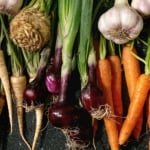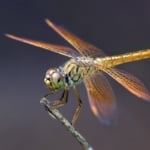Why Do We Eat Certain Foods at Easter and Passover?
Ever wonder why we eat ham and hot cross buns at Easter, and matzoh at Passover? We explain where the traditions came from.

‘Tis the season for Easter and Passover. While there are many celebrations, customs, and religious observations that occur this week, there are also many traditional foods that are served and consumed. Ever wonder why we eat certain Passover and Easter foods during these holidays?
Traditional Foods Eaten at Passover

Some of the traditional foods served during Passover include:
Matzoh – Three unleavened pieces of matzohs are placed in folded napkins as a reminder of how quickly the Israelites had to flee Egypt, leaving no time for the dough to rise.
Horseradish is served to symbolize the bitterness of slavery.
A mixture of apples, nuts, wine, and cinnamon—referred to as Charoses—is another food eaten during Passover and is supposed to remind people of the mortar used by the Jewish slaves when they constructed buildings.
Roasted lamb shank bone, referred to as Zeroah, represents the paschal offering.
A bowl of vegetables, usually celery, called Karpas, is another traditional food that represents hope and redemption.
Easter Food Traditions

Christians celebrate Easter with some traditional foods but seem to have more regional and family favorites rather than religiously dictated foods.
Ham is often served at the Easter table, which may seem odd since Jesus was Jewish and wouldn’t have eaten pork. It seems that this holiday food comes more from the timing of Easter rather than a religious meaning. Years ago, hams served during the Easter holiday were from meat that was originally slaughtered in the fall and cured throughout winter months. Since the holiday of Easter falls in spring, this celebration was cause to use the last of the winter-cured meats.
Eggs are a big part of the Easter tradition. Eggs are traditionally connected with rebirth, rejuvenation, and immortality. Since Easter is celebrated as the resurrection of Jesus and is observed in the spring (a time when flowers, grass, and other vegetation is born again), there’s an obvious connection with this food that reminds people of rebirth. Another reason may be that eggs during early Christian days were forbidden during Lent. So after the 40 days of not eating them, Easter was a welcomed day to eat eggs once again.
Hot Cross Buns —Bread is a big part of many religious traditions and ceremonies, but the origin of hot cross buns predates Christianity in Europe. Supposedly the buns were made to celebrate the spring equinox in pagan societies, and have since been served during the Easter season.
Try these Easter Dinner Favorites!
What other traditional foods do you eat/serve on either Easter or Passover? Tell us in the comments below.

Deborah Tukua
Deborah Tukua is a natural living, healthy lifestyle writer and author of 7 non-fiction books, including Pearls of Garden Wisdom: Time-Saving Tips and Techniques from a Country Home, Pearls of Country Wisdom: Hints from a Small Town on Keeping Garden and Home, and Naturally Sweet Blender Treats. Tukua has been a writer for the Farmers' Almanac since 2004.












The coloring of the eggs were originally done in red and According to this tradition, after the Ascension of Jesus, Mary went to the Emperor of Rome and greeted him with “Christ has risen,” whereupon he pointed to an egg on his table and stated, “Christ has no more risen than that egg is red.” After making this statement it is said the egg immediately turned blood red.
I fallow my parents customs for Easter, fish or tuna salad every Friday until Easter Sunday than to celebrate Easter Carne Asada with other side dishes ? and for dessert Capirotada ? which is like bread pudding.
Given that Jesus lived in the eastern Mediterranean, we do a six to eight course Mediterranean mezze which includes lamb, tzatziki, tabbouleh, hummus, baba ganousz, homemade pita bread, and a pie made from charoseth (which ends up being very similar to mincemeat pie, without the meat).
And deviled eggs. (We’re from the South. You don’t have holiday meals in the South without deviled eggs!)
Our family eats potato salad wings wagon wheel salad and other assorted foods deviled eggs pasta tuna salad olives cheesecakes so tasty
Our family ear
I didn’t mean ear
The Easter tradition of eggs was incorporated by the Dutch. Lady Freia (german goddess) saved a little birds life. The only way to do so was to change it into a rabbit, so that it wouldn’t be able to fly again. Every year the rabbit (former bird) would come lay the most beautiful eggs for the goddess. This is also where we get chocolate bunnies. Incorporated into america by the Pennsylvania Dutch. Spellings may not be perfect. The point was what most people already know, the catholic church stole bits and pieces of pagan holidays (dates, ideas, etc) and used them in catholic holidays to make the pagans more easily accepting of Catholicism. It was good PR on the Roman’s part.
Thank you, I had no idea, Michael!! Where did you come upon this knowledge? I have a huge interest in such things. Amazing, really!!
I think easter is all mixed up. JESUS only died and raised up once. Nobody knows exactly when. So pick one specific day for each year and leave it that way. Personally, I celebrate His birth,death ,and resurrection on Christmas and easter. Spending time teaching my children the truth of what the BIBLE says about JESUS. As for food on those holidays, its whatever we have at the time. Praise and worship from a clean heart and spotless soul are what we need to give to JESUS.
ALL THE TIME. Its good to have a time set aside for that reason, but I feel like we should all make more effort to remember HIM every day.
The Fact that JESUS Did provide us a way of escape from hell is way more than any of us deserve.but HE did it out of love.
Amen I agree
They kinda glossed over the fact that Easter was “created” and placed into existing spring equinox Pagan celebrations that had been going on since the Druids thousands of year before Christ. Eggs and rabbits are Pagan symbols of fertility much, much older than 2,000 years.
this comment applies not just to Easter, but to all of the Christian and probably other religions’ holidays. all of the Saints’ “days” mark divisions on the lunar/solar calendar.For example, Saint Valentine’s Day is halfway between the winter solstice and the Spring Equinox.
The Last Supper was Jesus and his fellow Jewish disciples celebrating Passover, so they pretty much know when it happened, and that is why we celebrate it when we do. And many of the Saints’ days are celebrated on the date of their death, when known. But you are still partially correct, that some dates are not known so they are associated with various times of the year. And yes, many of the foods and civil traditions come from local customs, which at first were typically rooted in Pagan traditions. I’m sure God doesn’t care what we eat, what we wear or how we decorate, as long as we celebrate His great love for us as show through the Passion, Death and Resurrection of our Lord and Savior, Jesus Christ.
No Professor, they know exactly when Jesus’ passion, death and resurrection are, due to the Last Supper being the Jewish celebration of Passover.
There’s are a few certain dishes we would make for Easter in my Italian family to be served for Easter or given as gifts to relatives. Pasteria di Grano– a pie made with –wheat, ricotta cheese and dried citrus with orange or lemon flavoring. Pizza Rustica— a pie made with ricotta and parmesan cheeses, eggs, prosciutto, ham, and salami. Braided Easter bread –a brioche with dyed decorated hard-boiled eggs. Struffoli—fried mini dough balls made into a mound and drizzled with honey and nonpareil candy. These are all served for Easter brunch after church services to symbolized end of Lental fast.
MariaRose, all those sound delicious! We have an Easter bread recipe that came from Patsy’s Bakery in NYC: Italian Easter Bread with Colored Eggs Recipe
Thank You for recipe !!